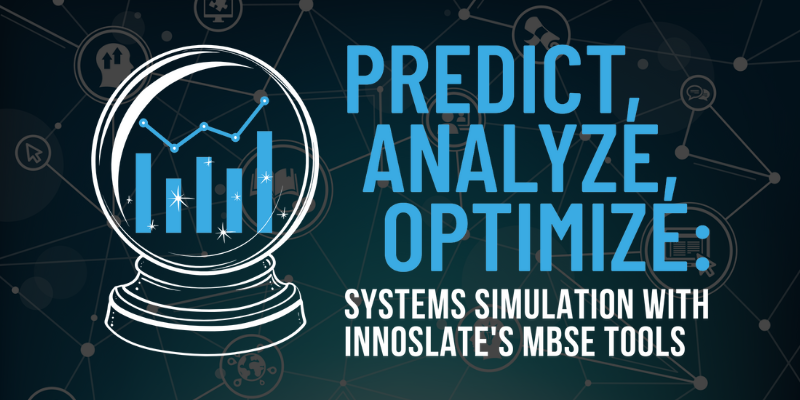The Role of Simulation in Informed Decision-Making
In today’s demanding world where there is little tolerance for error, there are decisions that need to be made daily for complex systems with often...
%20(200%20%C3%97%20100%20px)%20(800%20%C3%97%20400%20px)%20(5).png)
Systems engineers rely on various modeling languages to visualize and analyze complex systems. Common languages include Integrated Definition (IDEF), Unified Architecture Framework (UAF), Unified Modeling Language (UML), Systems Modeling Language (SysML), DoDAF Meta Model 2.0 (DM2), AP233, and Lifecycle Modeling Language (LML). These languages provide frameworks for creating diagrams and structuring systems engineering data. However, their ontologies vary in flexibility and scope, affecting their ability to capture the full complexity of modern systems engineering.
This article is perfect for Model-Based Systems Engineering Beginners who want an overview of key modeling languages.
IDEF was developed for systems and software engineers and includes multiple modeling methods. The most widely used is IDEF0, a functional modeling language designed to represent system processes clearly and concisely. While it is useful for structured analysis, it lacks modern object-oriented modeling capabilities.
Keep Learning:
The Unified Architecture Framework (UAF) is a modeling standard developed by the Object Management Group (OMG) to support enterprise and systems architecture. It provides a structured approach to managing complex systems by integrating various viewpoints, including operational, capability, services, and standards perspectives. UAF is widely used in defense and enterprise architecture projects to ensure alignment between business and technical domains.
Keep Learning:
UML originated as an object-oriented modeling language for software development. SysML was later introduced as an extension to improve communication between systems engineers and software developers. While widely adopted, SysML does not inherently solve systems engineering challenges like poor requirements analysis or inadequate verification and validation (V&V) planning. Additionally, its complexity can pose challenges for broader stakeholder adoption.
Keep Learning:
The DoDAF Meta Model 2.0 (DM2) was developed to enhance architectural utility within the Department of Defense. It provides a rigorous data model tailored for DoD-specific needs but lacks prescribed diagrams, requiring customization for effective use. While powerful for DoD-specific applications, it is less commonly used outside of defense-related projects.
Keep Learning:
AP233 was designed as a Standard for Exchange of Product data (STEP) to facilitate interoperability among systems engineering tools. However, its adoption remains limited due to challenges in tool implementation and lack of widespread industry support.
Keep Learning:
LML was developed to address the limitations of existing modeling languages by providing a simple yet comprehensive framework for all stakeholders in the systems engineering lifecycle. Unlike other modeling languages, LML is designed to support both systems engineering and program management needs simultaneously.
Simplicity: Uses only 12 primary entity classes, such as Action, Asset, Cost, Decision, and Risk.
Flexibility: Supports both functional and object-oriented approaches.
Interconnectivity: Entities relate logically, ensuring consistency in relationships.
Traceability: Enables information tracking across system lifecycle stages.
Ease of use: Reduces complexity by maintaining a common schema across different disciplines, including systems engineering, architecture, and program management.
Keep Learning:
Selecting the best modeling language depends on project requirements:
For structured functional modeling: Use IDEF.
For enterprise and defense architecture: Choose UAF.
For software-intensive systems engineering: Opt for SysML.
For defense architecture compliance: Use DM2.
For data exchange and interoperability: Consider AP233.
For a balanced, stakeholder-friendly approach: LML is the most versatile option.
Each of these standards has strengths and weaknesses, and the best choice depends on the complexity and goals of the project.
Looking for a powerful tool to model and analyze your systems engineering data? Innoslate, powered by LML, offers advanced capabilities to enhance decision-making. Sign up today to streamline your systems engineering process!
The systems engineering community is offered many different modeling language standards. You should choose the standard that meets your goals. If you are working with the DoD Architecture Framework, then you should choose to use the DM2 standard. Many assume SysML makes the best model-based systems engineering since it has been around the longest. However, LML is the best language for all stakeholders because it works for systems engineers, architecture developers, and program managers.
Looking for a powerful tool to visualize and analyze your systems engineering data? Start making data-driven decisions with Innoslate. Sign up now!
Have questions about model-based systems engineering or requirements management? Talk to an expert and see how Innoslate can streamline your projects from start to finish.

In today’s demanding world where there is little tolerance for error, there are decisions that need to be made daily for complex systems with often...

Traditional Standard Operating Procedures (SOPs) often fail to account for human performance variability and real-world time constraints, leading to...

Not up for the read? Watch the webinar recording!